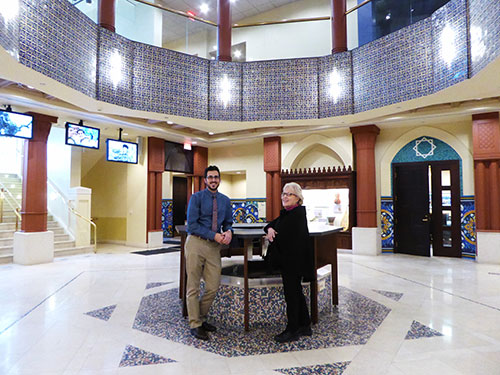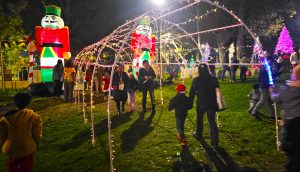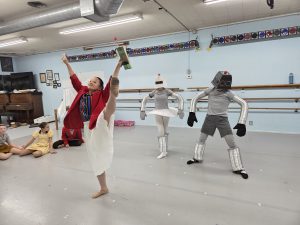Teacher Christa McAuliff, a crew member on the ill-fated 1986 Space Shuttle Challenger, and actor Danny Thomas, founder of St. Jude Children’s Research Hospital.
Renowned heart surgeon Dr. Michael DeBakey, consumer advocate and former presidential candidate Ralph Nader, Olympic boxer Sadam Ali, cartoonist and chief creative officer of DC Entertainment Geoff Johns and auto racing legend Bobby Rahal.
What do these diverse people have in common?
All are Arab Americans who have made an impact on the world. All share a place of honor in the Arab American National Museum (AANM) in Dearborn, Michigan. It is the first and only museum in the United States devoted entirely to Arab American history and culture.
The museum, a program of the Michigan human services nonprofit ACCESS (Arab Community Center for Economic and Social Services), was first envisioned in 2000. The Sept. 11, 2001, airplane attacks that destroyed New York City’s World Trade Center accelerated progress on the museum.
“After 9/11, the Arab American community galvanized around the idea of having a museum. They realized they needed a place to have an accurate representation of their story,” said AANM Research and Content Manager Matthew Jaber Stiffler.
Dearborn, home to the world headquarters of Ford Motor Company, was the ideal location for the museum, which was financed through private funding and grants and opened in 2005. Dearborn has the highest concentration of Arab Americans of any U.S. city.
In California, the Los Angeles area has a higher population of Arabs, but they are more spread out. In the Bay Area, Santa Clara County has a higher percentage of Arabs than surrounding counties. The City of Santa Clara ranks 99th statewide with just under one percent of the City’s population (now estimated at 126,000) identified as Arab.
The mission of the AANM is to document, preserve and present the history, culture and contributions of all Arab Americans. The second floor of the two-story museum is devoted to telling the stories of the Arabs who came to America, depicting their life in America and sharing their impact on the world.
Misconceptions
The AANM hopes to dispel misconceptions about Arab Americans through its interactive and multi-media displays. One misconception the museum clears up is the issue of who exactly an Arab is.
Arab is not a race. The term Arab refers to diverse people who share a common cultural background and geography. They trace their roots to one of the 22 primarily Arab-speaking states within the Arab League, which reaches from North Africa to the Middle East. Arab countries include Egypt, Iraq, Jordan, Lebanon, Morocco, Palestine, Saudi Arabia, Sudan, Syria and Tunisia. Afghanistan, India, Iran and Pakistan are not Arab countries.
Another misconception is that all Arabs are Muslim. While it’s true that outside the U.S. most are Muslim, some are Christian and others are Jewish. In the U.S., about half are Christian.
“I didn’t think of Arab countries as having Jews and Christians,” said museum visitor Kathy Dowling from Farmington, MI. “It’s not your religion that makes you an Arab, it’s the country and culture you’re from.”
Her tour of the museum broadened her view of the contributions of Arab Americans to society.
“You more often think about Arab Americans in entertainment,” said Dowling, “but touring the museum made me much more aware of the contributions made by Arab Americans in medicine and science.”
Documenting Stories
“Even if you can’t get here in person, we have a large presence on line, a large archival collection and oral histories,” said Stiffler. “[If you are Arab American], you can do oral histories online and send digital photos to contribute your history and family story.” Email Stiffler (mstiffler@accesscommunity.org) for information on documenting your story. The museum includes a research library.
“Visiting the museum was a very pleasant experience. It broadened my perspective and made me hopeful for the future of our country in these troubled times,” said Dowling, who noted interesting additions to the museum since her first visit several years ago.
“We’re all Americans, and the Arab American culture is a segment of our population we should get to know and celebrate,” said Dowling.
The Arab American National Museum (www.arabamericanmuseum.org), located in the metropolitan Detroit, MI, area, is accredited by the American Alliance of Museums and is an Affiliate of the Smithsonian Institution.
“At heart, this is an immigrant museum. Anyone whose family has immigrated can see their stories reflected here,” said Stiffler.
Note: If you can get to the AANM on a visit to Michigan, be sure to eat at one of the many Middle Eastern restaurants in Dearborn. Dowling enjoys La Shish, 12918 Michigan Ave. (www.lashishrestaruant.com). Closer to Santa Clara, Dishdash in Sunnyvale (www.dishdash.net) is a popular Middle Eastern restaurant.












0 comments